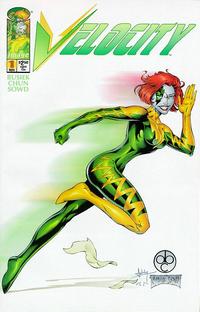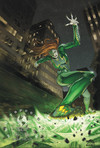 After reading more about the breakdown of the Velocity ongoing series that would have launched this year, I realized it would have been something very rare: An ongoing solo book about a speedster who wasn’t the Flash.
After reading more about the breakdown of the Velocity ongoing series that would have launched this year, I realized it would have been something very rare: An ongoing solo book about a speedster who wasn’t the Flash.
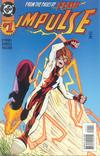 Off the top of my head, the only series I could think of was Impulse, which ran for 89 issues from 1995 through 2002…but even that was about the Flash’s cousin, who has since become Kid Flash (and was briefly the Flash). There was Top Cow’s Velocity miniseries that I’d just read, and Marvel’s Son of M miniseries starring Quicksilver, and the occasional special…but all of the long-running characters I could think of were either team members like Quicksilver (Avengers), Velocity (Cyberforce) and the Blur (Squadron Supreme), or Golden Age characters who appeared in anthologies, like DC’s Johnny Quick (More Fun Comics), Timely’s Whizzer (USA Comics), or Quality’s Quicksilver (National Comics — and he’s better known now as Max Mercury).
Off the top of my head, the only series I could think of was Impulse, which ran for 89 issues from 1995 through 2002…but even that was about the Flash’s cousin, who has since become Kid Flash (and was briefly the Flash). There was Top Cow’s Velocity miniseries that I’d just read, and Marvel’s Son of M miniseries starring Quicksilver, and the occasional special…but all of the long-running characters I could think of were either team members like Quicksilver (Avengers), Velocity (Cyberforce) and the Blur (Squadron Supreme), or Golden Age characters who appeared in anthologies, like DC’s Johnny Quick (More Fun Comics), Timely’s Whizzer (USA Comics), or Quality’s Quicksilver (National Comics — and he’s better known now as Max Mercury).
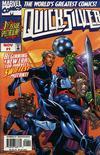 I remarked on this on Twitter, and @cm22 pointed out one more: Marvel launched a Quicksilver series in 1997, though it only lasted 13 issues.
I remarked on this on Twitter, and @cm22 pointed out one more: Marvel launched a Quicksilver series in 1997, though it only lasted 13 issues.
So that’s two. Impulse, which is a Flash spin-off, and Quicksilver, which lasted only a year. Three if you count the upcoming Kid Flash series announced over the weekend, but then again it’s Kid Flash.
For comparison, DC has published an ongoing Flash series from 1940–1949, 1959–1985, and 1987–2008, with only a few months off in early 2006 during Infinite Crisis.
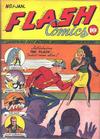
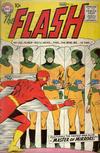
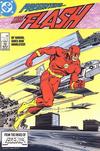
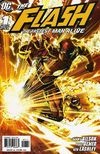
In the last 70 years, there have been only 11 in which no issue of Flash appeared. In the last 50 years, there has been only one year without a Flash book, and that was 23 years ago.
If there was any question that the Flash was the most successful example of the speedster super-hero archetype, this should settle it!
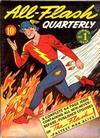 Note: It’s arguable that Flash Comics shouldn’t count, being an anthology series…but on the other hand, his name is in the title, his story was always the first feature, he alternated the cover spot with Hawkman, and the numbering was picked up for the 1959 Flash solo series. Besides, during most of the time Flash Comics was on the stands, DC also published All-Flash (1941–1948), which was definitely a solo Flash book!
Note: It’s arguable that Flash Comics shouldn’t count, being an anthology series…but on the other hand, his name is in the title, his story was always the first feature, he alternated the cover spot with Hawkman, and the numbering was picked up for the 1959 Flash solo series. Besides, during most of the time Flash Comics was on the stands, DC also published All-Flash (1941–1948), which was definitely a solo Flash book!
Thanks to the Grand Comic Book Database for the cover thumbnails.
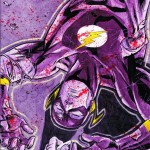 According to Diamond’s shipping changes and DC’s page for the issue, The Flash #3 has been rescheduled from June 9 to June 23.
According to Diamond’s shipping changes and DC’s page for the issue, The Flash #3 has been rescheduled from June 9 to June 23.
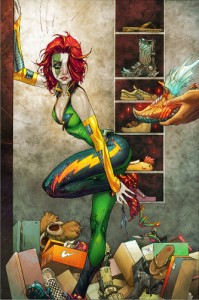 Wally West isn’t the only red-headed speedster out there. Velocity, winner of Top Cow’s first Pilot Season, will finally be getting her own series this May.
Wally West isn’t the only red-headed speedster out there. Velocity, winner of Top Cow’s first Pilot Season, will finally be getting her own series this May.






 Note: It’s arguable that Flash Comics shouldn’t count, being an anthology series…but on the other hand, his name is in the title, his story was always the first feature, he alternated the cover spot with Hawkman, and the numbering was picked up for the 1959 Flash solo series. Besides, during most of the time Flash Comics was on the stands, DC also published
Note: It’s arguable that Flash Comics shouldn’t count, being an anthology series…but on the other hand, his name is in the title, his story was always the first feature, he alternated the cover spot with Hawkman, and the numbering was picked up for the 1959 Flash solo series. Besides, during most of the time Flash Comics was on the stands, DC also published 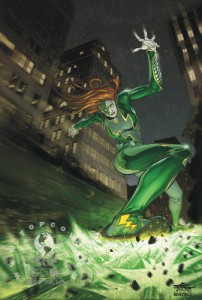 Just last week, I read and
Just last week, I read and 